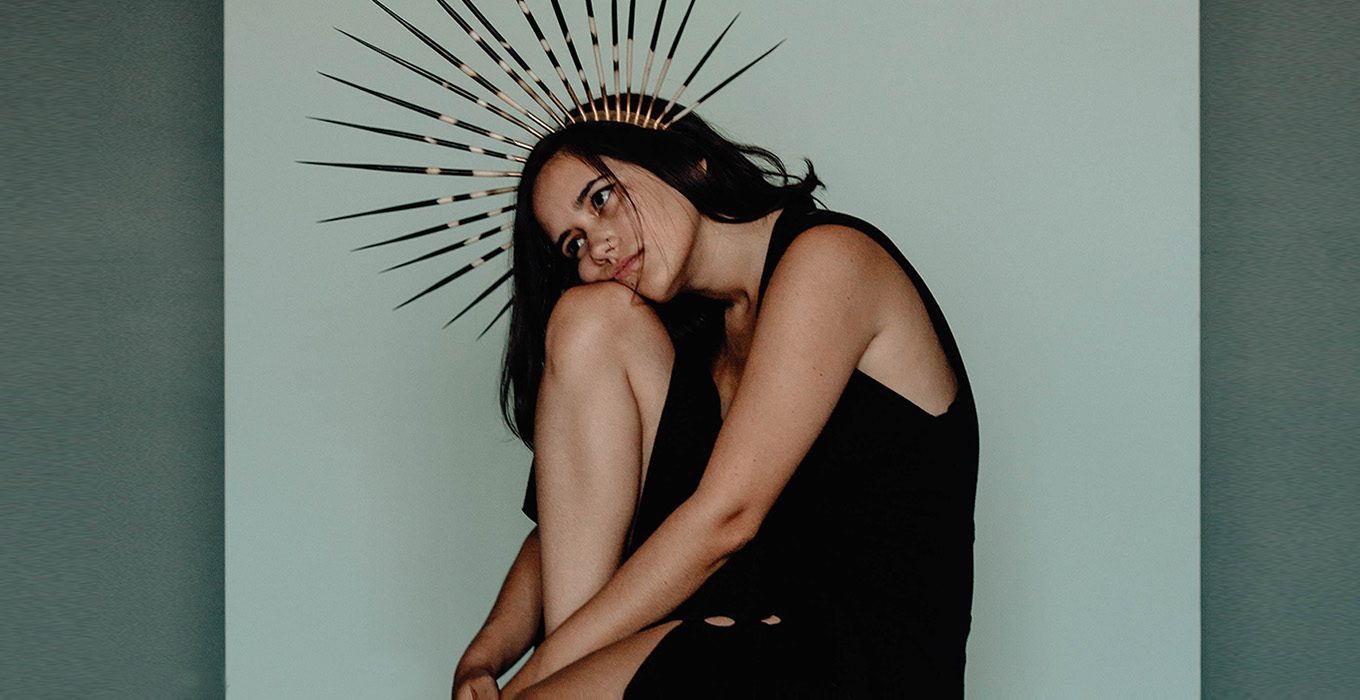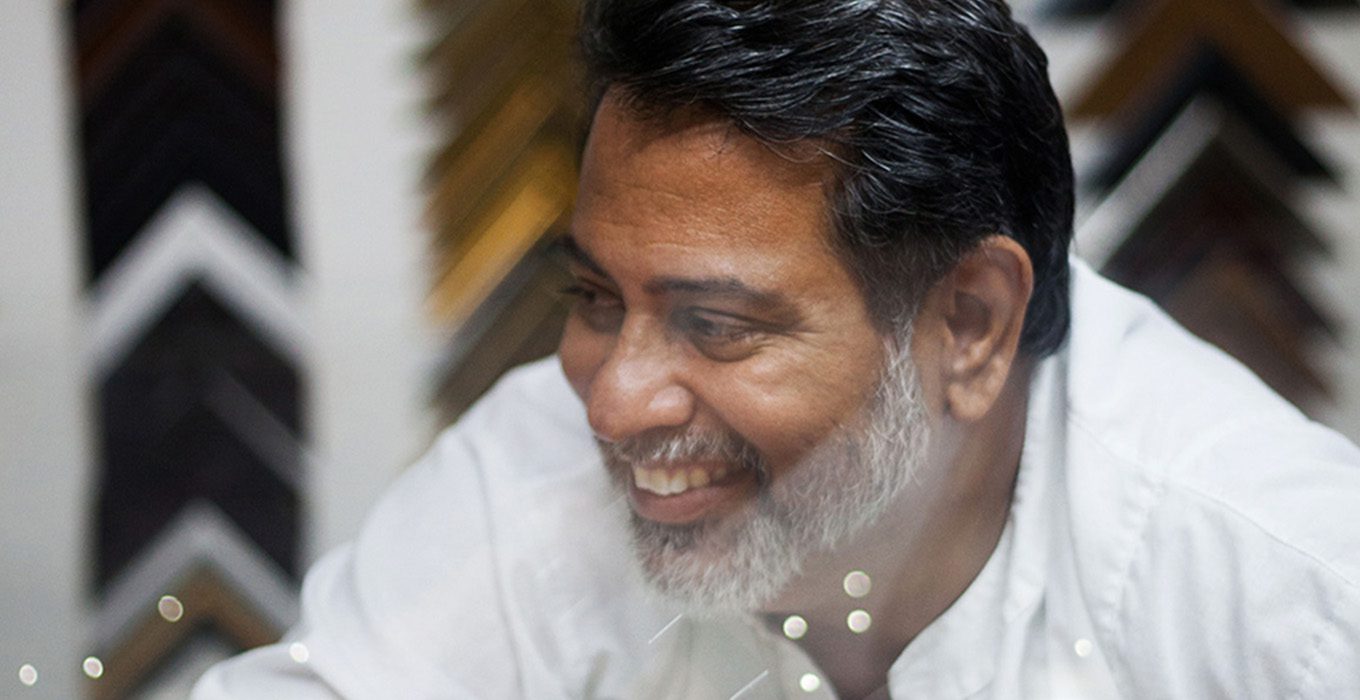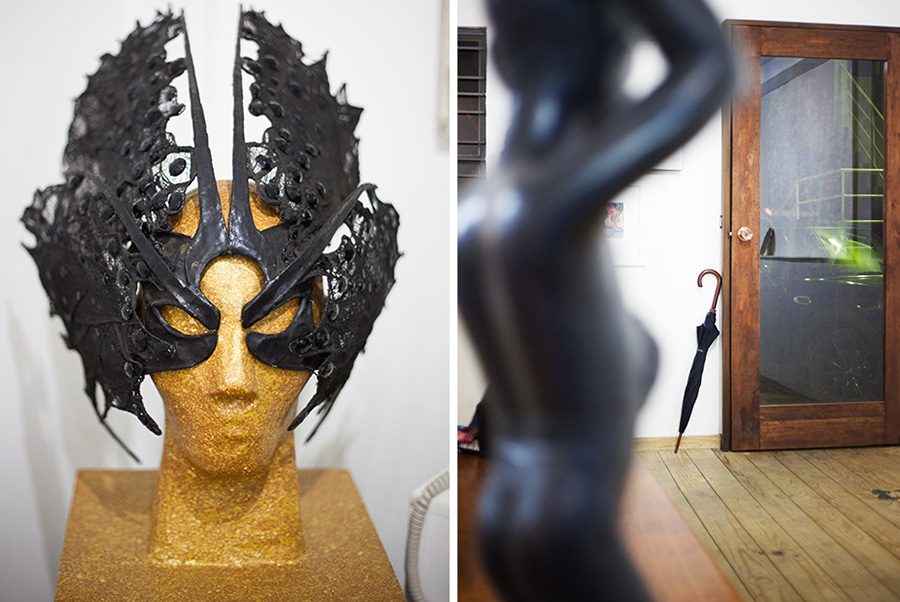

September 19, 2015
Nestled almost secretly in the shade of a pink poui tree, on the southwestern corner of Carlos and Roberts’ streets in Woodbrook Port of Spain Trinidad is The Frame Shop.
Peeking in through the glass of the large door invites the tingle of excitement throughout your body that can be compared to a kid in a candy store. It feels as if you are waiting to enter another world. The large wood and glass door that looks like a large frame itself, subconsciously engages you to participate in the framing activity. You can frame fractions of artwork that hang on the gallery walls or the blue room with its well lit stark white showcase of jewelry among other little gems.
Once you step over the threshold your anticipation is justified as the noise of the world outside, zones out while the white walls of the new gallery with the artwork of Paul Kain, Embah, Shalini Seereeram and others including, Ashraph himself draw you in. The entire space infuses your being with the potency of this creative catalyst that is only further intensified when greeted by Ashraph Ramsaran.
Born in 1965, self taught and working with a variety of media for over 30 years he has been shown not only in several spaces in Trinidad such as Y Art Gallery, The Museum of the City of POS and CCA7 but also regionally. When he greets you at the door of The Frame Shop he is always smiling and welcoming and makes you feel more than just welcome. He makes you feel at home with the soft sound of old calypso playing in the background from the white Macbook in the corner of the gallery space, to the smell of just finished burning incense. A comfort exists that puts your entire being at ease. As he ushers me into the framing room of the Frame Shop where there are sheets of glass ready to be cut for frames and pictures showing some of the work that will be shown in his next solo show Black Indian, it is impossible not to fall in love with the work and the man himself.
Tell us about your space.
ASHRAPH: It is my little gallery. The people that I like get to be in here. I have been in this art thing since I was 17 or 18 and I’m 50. I have been doing this framing for 20 years so I have known some of these artists for 25 years or more and some of their work I like and some I don’t. It is just a personal thing. I have a lot of friends with gallery spaces and my space is not better than anybody else’s. It is just that I am willing to take a chance and show the work you don’t see in everybody else’s space, like the little odd Embah or Parker, because I believe in their work. I myself buy this work. I myself have this work on my wall. Everything I have in here is from artists that I have invested in. I have tried to get younger people to purchase art and not only pretty landscapes. My thing is to showcase the artists that I like, the artists that I am willing to spend my money on. Work that me, Ashraph, can say is worth it and have on my walls at home.
We know you love Embah…
ASHRAPH: Hahahaa. That’s a good one! I met Embah way back in 1989/1990. He was a character. He would tell these stories and his work was always found objects. It forced you to think that art is not just picking up a paint brush and painting. It is about taking stuff and creating objects or a collage. Some of his figures float like a dream-like something and I like that. They may not be as romantic as they are dark but that is ok. Some of them are quite funny some of them could be serious.
“Embah would tell these stories and his work was always found objects. It forced you to think that art is not just picking up a paint brush and painting. It is about taking stuff and creating objects or a collage.”
How has his death affect you?
ASHRAPH: It is a great loss. I really have not thought about it… but it is a great loss. We have had all these discussions about him and having his work in the space, It is very difficult to think of what to do now that someone I really respect is no longer around. I think we lack artists that are as talented and as honest as he was with his work. Everybody wants to be an artist and every Monday morning there are about 5. I was going to do a show on bats and he would have had 6 pieces, Paul Kain has 6 canvases but Embah only completed 4 objects… but I am still going to show them.
So where do you think Art is going in the region?
ASHRAPH: Where? Well when I find out I will let you know. What art? When we think about art it is not just only painting. We don’t really have painters anymore, we are really limited with the painters and we have a shortage of sculptors. Everybody picks up a camera and they are a photographer. I am not a jeweler. But what am I? I design stuff and I get it made and I put my name to it. Jamaica seems more advance as painters.
How did you get started in the art world? Did you have formal training?
ASHRAPH: I had one art class when I was 16 and I decided that was not what I wanted to do. I did not like it. There was this guy call Bob Mackie who is a brilliant artist but I did not want to have to go through that process to paint a bottle and a bar of soap and an orange… that was not cutting it for me. After that I stopped and when I was in my 20’s I started back.
What inspired the start back?
ASHRAPH: I was working for a gallery located at Long Circular Mall at the time, so even though I was not painting I was involved in the art scene. I was going to shows and appreciating paintings and even performance art. Back then we were involved with the visuals of Minshall’s band, the Kings and Queens and the band Tantana. It was like performance art… most of it was performance art.
“It is like the influence that opened your eyes and ears and mind to see things in a certain way. He influenced the Mas Man in me”
So Minshall had an influence on you from way back?
ASHRAPH: I would say that, even though I played mas in Edmund Hart, I used to look at Minshall’s work and I would leave my band and go running to see his band coming up the road and look at the costumes. Then as I got older I wondered why am I doing this, why am I not there? He influenced me from way back then so it will not go away, it is always there. It is like the influence that opened your eyes and ears and mind to see things in a certain way. He influenced the Mas Man in me but the artist influences I had back in those days were, I would say, Cozier and Eddie Bowen.
The relationship you have with Cozier and Bowen is it a mentoring relationship or was it just influence?
ASHRAPH: In the beginning you would see work that would inspire you and encourage you to come out of a comfort zone, to try something different. You don’t want to be them but it is all about finding your self. Back in the day I used to really love Lisa Choo-Foon’s work. She used to do these abstract paintings and a lot of people just thought they were pretty colours but to me it was so much more than that. There was an emotional and sensitive person that came out in her work and I like that.
What inspired the start of the Cat in Bag Productions Mas?
ASHRAPH: Well we had no more Minshall and we were bored wondering what to do, just kind of walking around Port of Spain, taking some pictures but I wanted to do something. Then one year, 3Canal had a show called Jab in the Box and we were talking about doing something and actually we did. We went out in the streets wearing costumes frm their show and we had such a good time and that’s how it started… from that, Jab in the Box to Tin Cow Fat Cow, which was inspired by one of their songs.
What is the theme for next year?
ASHRAPH: Next year is Pot Hound State. Nicholas Laughlin mentioned dogs when we were talking about it after we crossed the stage last year when we were walking back to The Frame Shop. It is always political. We were all saying the place gone to the dogs with the government at the time. Now we have a new government and so we have to see if the story changes and how it can be adapted to the dogs. We have to give this new government a chance. I mean if something happens the week before Carnival it will be that. As I said everything is pretty much cat in bag. Nothing is set in stone… set in bone! Hahahahaa.
What do think of Mas now? Or what would you call it?
ASHRAPH: Well everything has it time. A Minshall band might not work now because this generation might not want to wear those things. They are working so hard on their bodies that they just want to show it. I don’t enjoy it. It is not my kind of thing. I try to go to the Kings and Queens prelims because I actually enjoy that more than the King and Queens finals. Those big floats have no right to be there. They have no right to be even winning King and Queen of Carnival because they can’t go on the streets to parade. They are too big. It is just to wheel on to the Savannah stage and then to wheel off. They should change it so that they judge them throughout the Carnival maybe Monday and Tuesday and decide on Ash Wednesday or whenever. I don’t know. The costumes should just not only be for the Savannah stage. The costumes need to play mas… not the mas playing you.
What do you think is the biggest loss now in terms of the creativity or lack thereof and the artisans like wire benders etc?
ASHRAPH: The impact is huge. Look at the Kings and Queens you don’t see that type of thing there anymore. Look at the bands themselves… what are they saying? Their sections, the names and the costumes don’t match. You have a section called Pitch Lake and you have a set of yellow feathers with sequins, bikinis and beads? It is too abstract. I mean I love abstract but that is too abstract. They don’t think about what they are working on. That is just me though. I mean the boot makers no longer exist, the vendors on the streets they are feeling it as well because it is all about the fashion and making money. They are killing it all. It is all about the mighty dollar and the poor people not getting the dollar. It is not about the people who need the money anymore. I remember as a child seeing mas you would actually see something. It is totally different now. Even looking at it on tv now you don’t see much. Our coverage of the bands is rubbish. Maybe there should be more focus on the smaller bands and not these big bands. Encourage people to be more creative and bring back people who used to create the traditional mas because it is missing.
How did you get in to jewelry design?
ASHRAPH: Shalini Seereeram and I were working on the Carnival band called Corbeaux Town and I was at a studio one night and we were working on something for the eyes and she had some aluminum disks that we thought were kind of interesting. In the end we never used the disks and I was looking at them and thought they would look really interesting as rings, and they reminded me of a band that Minshall did once, so that is what inspired it. When Y Gallery was having their show I told them I had these things I was working on but I am not a jeweler. Then Rachel Ross and Jasmin Girvan said to me that a lot of people design stuff and get people to make it for them. They are not jewelers but they are designers… and that is how I got involved. I took their advice.
Give us a peek into the upcoming show Black Indian
ASHRAPH: This show was inspired by a line in a David Rudder song ‘The Long Time Band’, ‘… then the Black Indian chant out in a rage… next thing they on the Savannah stage!’ I just love that Black Indian he made an impression. That Black Indian made an impression and ever since I heard that one line, every time I saw a Black Indian for Carnival I had to take a picture. For me it is no longer about the costume it is about the face, the oil and the reflection of light and the texture of the make-up. Even if the person has a beard the oil and the paint and the light reflecting so every time he turns, it is different. I am more interested in that than all the fluff around it.
How long have you been working on this show?
ASHRAPH: I actually started since last year and I was hoping to show it for Jewel Box but then they came up with a name for Jewel Box called ‘Light’ and I had to create a new collection for that show and I did fireflies and so I had to put this on hold. This is not a jewelry show though I look at it as objects. I look at the jewelry as adornment on the costume for the masquerade the focus is the face. Some of the jewelry is wearable some may not be, but people need to think out the box and make a little statement sometimes.
What do you think of the sudden growing volume of designers doing so many things including clothing and jewelry popping up now?
ASHRAPH: That is like, we have so many artists and not enough artists. Everybody is an artist. Everybody jumped out of art school and wants to be an artist. I’m not saying that they are not, but it does not happen overnight. It takes a while and some of the galleries encourage that by wanting to sell everything under the sun and sell it for these prices… but what have you done to charge these prices? Some of the older artists are still charging at those prices… what have you done to be able to also have such prices on your work? So it really is kind of strange. I have serious issues with that and that will not happen in my space. A lot of what is being created is actually craft. There is craft and then there is jewelry. I know what I start with is considered craft until I go and get somebody to cast it in silver. Take something that is $20 and make it look like $200. Take it up a notch but we are not good at doing that here.
Is that because the consumer is willing to accept less and so therefore the producers don’t feel the need to give the extra push?
ASHRAPH: I think it is laziness. It is something that has been going on for so long. If we were doing it the right way all along it would not be a problem. Some people would demand more. I am not going to buy these painting from these young artists for $7000 but there are some people who will. It is ignorance, and people would say to me that it is ignorant of me to say that. I think they have to creep before they walk but they want to run. They come out of art school and they are still painting like whoever taught them. They need to take some time to undo what they taught you and come in to your self before you can start to sell, especially for those prices they want.
Okay… last one. Who do you think is the next big thing?
ASHRAPH: Huh. That is putting pressure on people. It is setting them up for falls. When it happens it happens. We are good at that, putting people up on a pedestal and then kicking it right out from under them if they don’t meet our expectations. I hope something happens soon though.
Thanks for chatting with us Ashraph.




INTERVIEWER: INDRA RAMCHARAN Photographer: NADIA HUGGINS